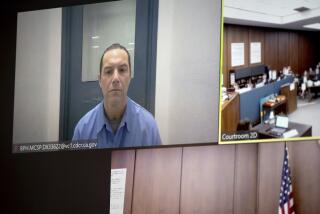Judge’s Ruling a Blow to Peyer’s Defense : Testimony of Fiber Expert Is Restricted
- Share via
Dealing a blow to attorneys representing former California Highway Patrol Officer Craig Peyer, a Superior Court judge Monday restricted the allowable testimony of a fiber expert the defense called as a witness in the ex-patrolman’s first murder trial.
The ruling bars John Reffner from testifying that the dye in three fibers recovered from Peyer’s gun and left boot differs from that of fibers taken from purple sweat pants worn by Cara Knott, who was killed Dec. 27, 1986.
Reffner’s testimony in the first trial contradicted that of prosecution experts, who said all four microscopic purple fibers matched and thereby linked Peyer to Knott’s murder.
Judge Richard Huffman said Reffner’s methods--detailed during a court hearing last week--are not useful for analyzing the fiber evidence present in the Peyer case and would merely “confuse and mislead” the jury.
Moreover, Huffman warned that he might block Reffner from testifying altogether if prosecutors can prove their allegation that his forensic technique is not widely accepted within the scientific community.
“I’m fully willing to throw it out if you establish that (Reffner’s technique) is not reliable,” Huffman told Deputy Dist. Atty. Paul Pfingst, who is prosecuting Peyer.
The judge added that, if he allows Reffner to appear as a witness, he will be permitted only to criticize the prosecution’s fiber expert and tell jurors that his “normalization” technique was available to the district attorney’s investigators.
After the judge’s ruling, Pfingst said, he plans to ask the prosecution’s fiber expert, Richard E. Bisbing, to study literature about Reffner’s methods along with Reffner’s testimony in the first trial and then render an opinion on the technique’s merit.
“We basically believe that his methods are without scientific validity,” said Pfingst, who noted in court that Reffner presented just one article and a promotional brochure to support his claim that his methods are widely embraced by forensic specialists. “We will ask our expert to examine the process and then tell us what he thinks.”
Peyer, 38, is accused of strangling 20-year-old Knott and throwing her body into a dry creek bed from an abandoned highway bridge near the Mercy Road exit on Interstate 15. The former patrolman’s first trial ended when a jury deadlocked, 7 to 5, for conviction on Feb. 25 after seven days of deliberations.
Fiber Testimony Critical
Because the prosecution’s case is built on circumstantial evidence, testimony about fibers linking Peyer to the killing is viewed as a critical ingredient. In the first trial, prosecutors relied heavily on expert testimony about six microscopic fibers they say prove Peyer murdered Knott.
Three purple fibers were lifted from Peyer’s service revolver and left boot by a police criminologist four months after Knott’s death. Bisbing, an expert in the color analysis of fibers, testified that those fibers matched purple strands from sweat pants Knott was wearing the night she died.
In an effort to challenge that testimony, defense attorney Robert Grimes called Reffner, who works as a consultant for the Connecticut State Police. Reffner, whose “normalization” method involves computing the amount of dye absorbed by fibers, testified in the first trial that the dye in the three purple fibers did not match that from Knott’s clothing.
“There’s no correlation between the fibers . . . on the boot or the gun,” Reffner told jurors on Feb. 5.
Reffner did, however, concede under cross-examination that two incriminating dark-blue fibers found in each of Knott’s hands are “consistent” with fibers taken from the CHP patches on Peyer’s jacket.
On Monday, Huffman said he was prohibiting Reffner from presenting his analysis of the fibers because, “by this expert’s own definition,” there is insufficient data for his methodology to work in this case. In order for Reffner’s technique to be applicable, the expert would need to know the full range of possible fibers in the fabric of origin, which is unknown.
Grimes declined to comment on the significance of Huffman’s ruling, which came on the heels of another damaging ruling barring the defense from suggesting to jurors that an unidentified hitchhiker may have killed Knott.
“I don’t think the judge has expressed a preference for either fiber expert,” Grimes said. He did concede, however, that the ruling “does limit Dr. Reffner’s testimony somewhat.”
More to Read
Sign up for Essential California
The most important California stories and recommendations in your inbox every morning.
You may occasionally receive promotional content from the Los Angeles Times.










